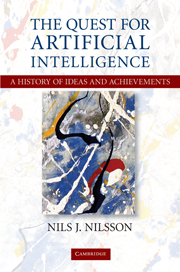Book contents
- Frontmatter
- Contents
- Preface
- PART I BEGINNINGS
- PART II EARLY EXPLORATIONS: 1950S AND 1960S
- PART III EFFLORESCENCE: MID-1960S TO MID-1970S
- 9 Computer Vision
- 10 “Hand-Eye” Research
- 11 Knowledge Representation and Reasoning
- 12 Mobile Robots
- 13 Progress in Natural Language Processing
- 14 Game Playing
- 15 The Dendral Project
- 16 Conferences, Books, and Funding
- PART IV APPLICATIONS AND SPECIALIZATIONS: 1970s TO EARLY 1980s
- PART V “NEW-GENERATION” PROJECT
- PART VI ENTR'ACTE
- PART VII THE GROWING ARMAMENTARIUM: FROM THE 1980s ONWARD
- PART VIII MODERN AI: TODAY AND TOMORROW
- Index
- Plate section
13 - Progress in Natural Language Processing
Published online by Cambridge University Press: 05 August 2013
- Frontmatter
- Contents
- Preface
- PART I BEGINNINGS
- PART II EARLY EXPLORATIONS: 1950S AND 1960S
- PART III EFFLORESCENCE: MID-1960S TO MID-1970S
- 9 Computer Vision
- 10 “Hand-Eye” Research
- 11 Knowledge Representation and Reasoning
- 12 Mobile Robots
- 13 Progress in Natural Language Processing
- 14 Game Playing
- 15 The Dendral Project
- 16 Conferences, Books, and Funding
- PART IV APPLICATIONS AND SPECIALIZATIONS: 1970s TO EARLY 1980s
- PART V “NEW-GENERATION” PROJECT
- PART VI ENTR'ACTE
- PART VII THE GROWING ARMAMENTARIUM: FROM THE 1980s ONWARD
- PART VIII MODERN AI: TODAY AND TOMORROW
- Index
- Plate section
Summary
As mentioned previously, the problems of understanding, generating, and translating material in ordinary human (rather than computer) languages fall under the heading of natural language processing. During the “early explorations” phase of AI research, some good beginnings were made on NLP problems. In the subsequent phase, the late 1960s to early 1970s, new work built on these foundations, as I'll describe in this part of the book.
Machine Translation
W. John Hutchins, who has written extensively about the history of machine translation (MT), has called the period 1967 to 1976, “the quiet decade.” Inactivity in the field during this period is due in part to the ALPAC report, which, as I have already said, was pessimistic about the prospects for machine translation. Hutchins claimed “The influence of the ALPAC report was profound. It brought a virtual end to MT research in the USA for over a decade and MT was for many years perceived as a complete failure.… The focus of MT activity switched from the United States to Canada and to Europe.”
One exception to this decade-long lull in the United States was the development of the Systran (System Translator) translating program by Petr Toma, a Hungarian-born computer scientist and linguistics researcher who had worked on the Georgetown Russian-to-English translation system. In 1968, Toma set up a company called Latsec, Inc., in La Jolla, California, to continue the Systran development work he had begun earlier in Germany. The U.S. Air Force gave the company a contract to develop a Russian-to-English translation system.
- Type
- Chapter
- Information
- The Quest for Artificial Intelligence , pp. 181 - 192Publisher: Cambridge University PressPrint publication year: 2009



